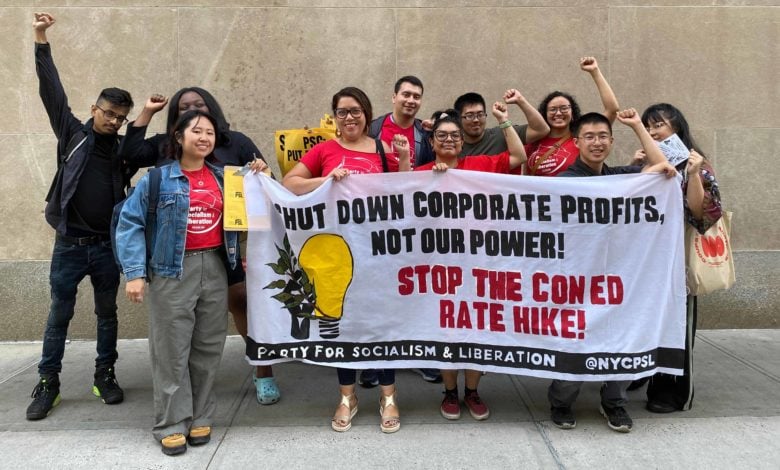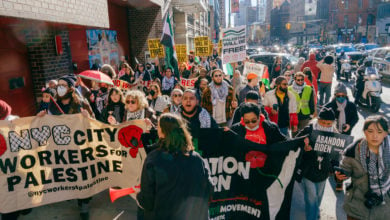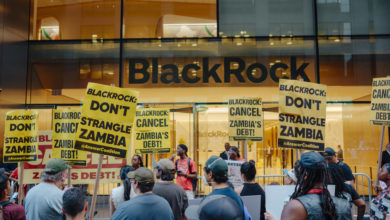
On Aug. 1, New Yorkers began paying even more to live after the Public Service Commission approved a 3-year rate hike plan for Con Edison energy customers. Despite more than 7,500 public comments on the commission’s web page overwhelming opposing the hikes, the state regulator approved increases of more than 15% and 20% for electric and gas, respectively, on July 21. According to the PSC’s own analyses, customers will now on average pay $14 more a month for electricity and $17 more a month for gas — and this will increase to $24 and $48, respectively, by January 2025.
The hikes come after Con Ed lobbied for over a year and a half for gas and electric rate increases in New York City and nearby Westchester County, New York. The multi-billion dollar company effectively holds a monopoly on the provision of utilities in both areas, and enjoyed record profits during peak pandemic years, reaping nearly $10 billion in gross profit in 2020.
Edmond Mathelier, a Queens resident, said of the hikes: “We’re tired. The city is becoming almost unlivable for the average person. You can’t have housing without energy. Without it you’re sitting in the cold. Our basic necessities are being treated as luxuries and we can no longer afford to pay.”
Initially, in January 2022, Con Ed asked for price increases of 11.2% and 18.2% for electric and gas, respectively, to take effect in 2023. After receiving significant pushback, the company revised its proposal a month later, requesting higher total increase rates of 12.37% for electric and 21.93% for gas to be implemented over three years.
The company has provided several justifications for these exorbitant hikes, include blaming the ongoing war in Ukraine, despite submitting their initial increase proposal a month before the invasion.
Con Ed also claimed that in addition to improving existing delivery infrastructure these increases are needed for investing in green energy. However, the company continues to invest millions in fossil fuel infrastructure, and it has no articulated plan to meet the state’s 2040 deadline for a complete transition to renewable energy.
Blow after blow: the cost of living crisis
These rising costs come on the back of the COVID-19 pandemic and the government’s insufficient response to it, part of the reason for the highest U.S. inflation rate in 40 years in 2022. At the same time rents are rising and a Metropolitan Transit Authority fare hike is planned for late August.
New Yorkers are already underwater financially. Since February 2020, electric and gas debts increased by 126%. By last spring, around 1.3 million households in New York State were at least 60 days behind on energy bills, and thus at risk of losing services since the utility shutoff moratorium ended in December 2021. Across the state, utility debts reached new heights according to the Public Utility Law Project totaling around $1.9 billion.
Much of this debt has been concentrated in New York City, with around 385,000 people owing utility debts to Con Ed averaging over $2,100 per household, and at least half a million people being considered “utility debt-burdened.”
“My mom’s lived here her whole life. I’ve been living here my whole life in New York City, but the city is becoming more and more inhospitable — not just to me, but to people who aren’t making tons of money,” said Mathelier.
Over these past three years, when poor and working-class New Yorkers needed the most support, politicians at the federal, state and city levels of government quietly ended the meager COVID protections and relief programs, including the eviction and utility shutoff moratoria.
In January, New York Governor Kathy Hochul announced a state budget plan designating around $700 million for utility debt relief — less than half of the $1.9 billion burden. Additionally, this relief would be subsidized through added surcharges on utility bills of other New York residents.
State greenlights profit extraction
Con Ed’s media spokespeople frequently emphasize the state policy that utility companies are not allowed to profit from selling energy and are forced to supply it “at cost.” However, the company generates massive earnings in the form of capital spending, with an estimated annual revenue of $16 billion and assets valued at $69 billion.
The company’s proposed spending plan has been extremely lucrative for shareholders, making record profits during the worst years of the pandemic and compensating its investors and executives accordingly. Last year, when its investors made $1.35 billion in profits, compensation for all key executives had more than tripled from only five years prior.
The Public Service Commission is the regulatory body overseeing the prices that private utility companies may charge for energy services. The board is comprised of seven governor-appointed commissioners. The self-stated mission of the PSC is to “ensure affordable, safe, secure, and reliable access to [utilities] at just and reasonable rates, while protecting the natural environment.” Yet, it keeps giving the greenlight to hikes. During the last round of hikes in January 2020, the PSC approved rate increases of 13.5% for electric and 25% for gas in yearly increments from 2020-22, meaning that prices were already rising every year during the pandemic.
People’s power for public power!
New York state and New York City are among the wealthiest places in the world. New York City has more billionaires than any other metropolitan area, with a combined wealth of $610.8 billion. Working New Yorkers already struggling should not be made to pay more for the basic necessities of life.
Alternate solutions exist. The state could implement a Stock Transfer Tax, also known as the “Robin Hood Tax.” The tax would take a fraction of a percentage of each stock transaction on Wall Street, generating billions of dollars in public revenue to lower energy costs and reinvest in renewable energy.
Energy companies like Con Ed could also be publicly owned, eliminating the profit motive from the provision of utilities entirely. Through public ownership and taxing Wall Street corporations and banks, we could use the city and state’s resources to meet the needs of the people and the planet.
“We’re facing the climate crisis — we just had the hottest week in human history, and now they’re charging us more for AC. The type of people it affects are disproportionately Black and Latino. It’s an issue that while it seems like it’s just one small thing, it’s an intersection of multiple issues, not just something small. A fight we have to fight on multiple fronts,” said Mathelier.






